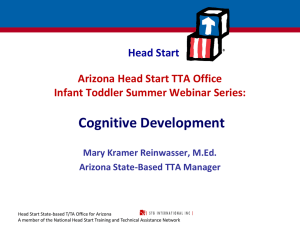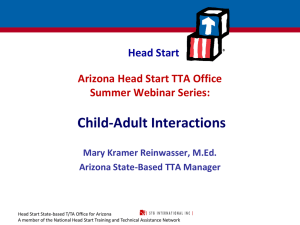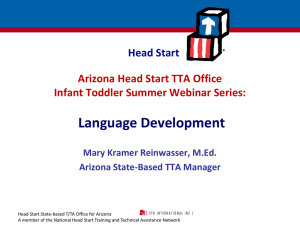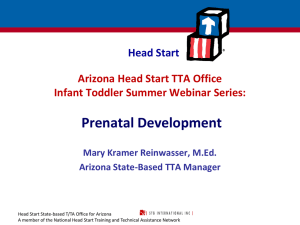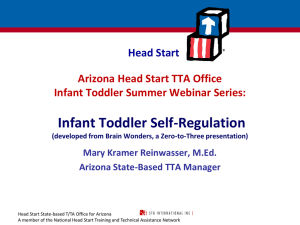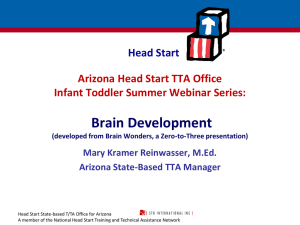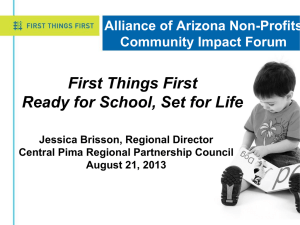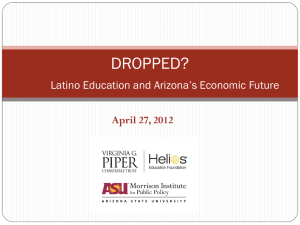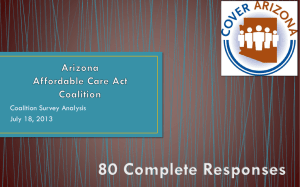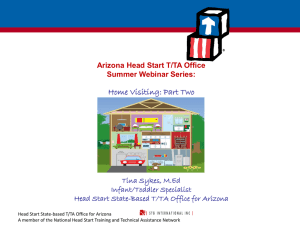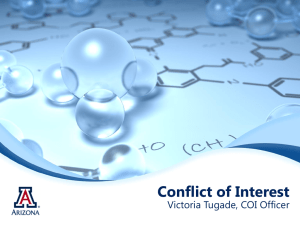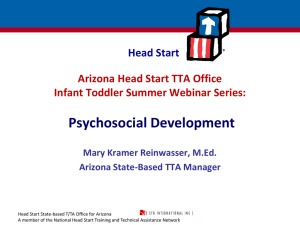Integrating Math Across the Curriculum
advertisement
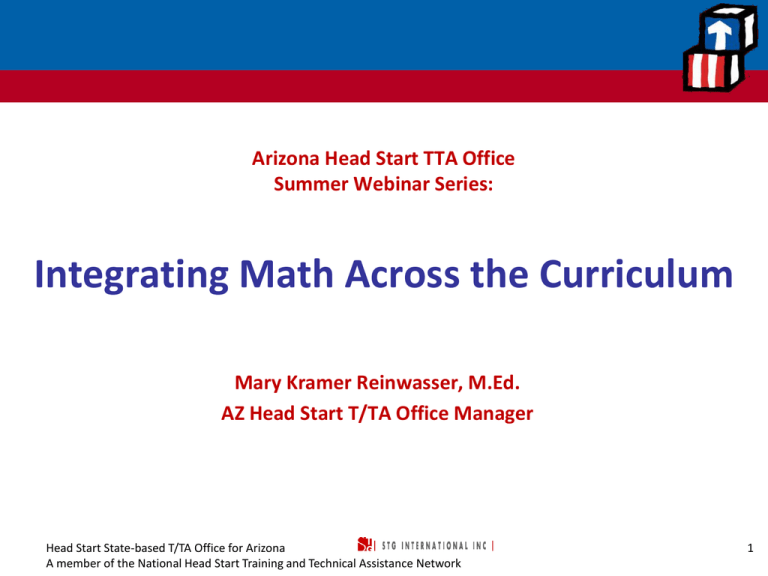
Arizona Head Start TTA Office Summer Webinar Series: Integrating Math Across the Curriculum Mary Kramer Reinwasser, M.Ed. AZ Head Start T/TA Office Manager Head Start State-based T/TA Office for Arizona A member of the National Head Start Training and Technical Assistance Network 1 Agenda • Discuss the importance of math • Review fundamental math concepts that develop during the preschool years • Strategize how to Create a Mathematical Rich Environment Head Start State-based T/TA Office for Arizona A member of the National Head Start Training and Technical Assistance Network 2 Learning Outcomes Participants will be able to: • Name fundamental concepts of math • Explain the importance of developing math skills in children • Identify several strategies to implement in the classroom that will encourage math skill development in children • Develop ideas for integrating math throughout the classroom environment Head Start State-based T/TA Office for Arizona A member of the National Head Start Training and Technical Assistance Network 3 Do you suffer from math anxiety? Head Start State-based T/TA Office for Arizona A member of the National Head Start Training and Technical Assistance Network 4 Why Math? • Math helps children find meaning in their environment. • In play, daily routines, and other meaningful activities, children question, analyze, and talk about their discoveries. • Mathematics is an area where many English language learners accelerate because they can manipulate materials, as well as their bodies and hands, to practice math skills. • Last, but by no means least, math knowledge, interest, and skills are basic to children’s success in school Head Start State-based T/TA Office for Arizona A member of the National Head Start Training and Technical Assistance Network 5 Fundamental Math Concepts Head Start State-based T/TA Office for Arizona A member of the National Head Start Training and Technical Assistance Network 6 Numbers and Operation OR Numeracy • Number sense involves the ability to think and work with numbers and to understand their uses and relationships. • "Operation" is the formal mathematical term referring to addition, subtraction, multiplication, and division of numbers Head Start State-based T/TA Office for Arizona A member of the National Head Start Training and Technical Assistance Network 7 Head Start Outcome Framework Domain #3 Element: Numbers and Operations • Demonstrates increasing interest and awareness of numbers and counting as a means for solving problems and determining quantity. • Begins to associate number concepts, vocabulary, quantities, and written numerals in meaningful ways. • Develops increasing ability to count in sequence to 10 and beyond. • Begins to use language to compare numbers of objects with terms such as more, less, greater than, fewer, equal to. • Develops increased abilities to combine, separate and name “how many” concrete objects. Head Start State-based T/TA Office for Arizona A member of the National Head Start Training and Technical Assistance Network 8 Number and Operations Strategies • Encourage children to count all sorts of objects and events and to think about quantity and number • Arrange materials and use games and verbal encouragement to involve children in matching and sorting objects, using oneto-one correspondence and ordering a set of objects that vary • Draw children's attention to numbers around them and what they are used for, such as finding addresses, prices of objects, and shoe sizes. • Use strategies to help children learn to count accurately and efficiently Head Start State-based T/TA Office for Arizona A member of the National Head Start Training and Technical Assistance Network 9 • Highlight the relationships critical to developing number concepts and operations • Help children to become familiar with the skills and vocabulary of estimating • Use math vocabulary words regularly including more than, less/fewer than, about, near, approximately, and in between • Make it a point to return to a problem type to allow children to try again. Head Start State-based T/TA Office for Arizona A member of the National Head Start Training and Technical Assistance Network 10 Geometry and Spatial Sense • Geometry is the naming and understanding of attributes of shapes and applying them to problem solving • Spatial sense is understanding the relationship of self and objects through position, directions, and distance Head Start State-based T/TA Office for Arizona A member of the National Head Start Training and Technical Assistance Network 11 Head Start Outcome Framework Domain #3 Element: Geometry and Spatial Sense • Begins to recognize, describe, compare, and name common shapes, their parts and attributes. • Progresses in ability to put together and take apart shapes. • Begins to be able to determine whether or not two shapes are the same size and shape. • Shows growth in matching, sorting, putting in a series, and regrouping objects according to one or two attributes such as color, shape, or size. • Builds an increasing understanding of directionality, order, and positions of objects, and words such as up, down, over, under, top, bottom, inside, outside, in front, and behind. Head Start State-based T/TA Office for Arizona A member of the National Head Start Training and Technical Assistance Network 12 Geometry & Spatial Sense Strategies • Encourage children to identify different shapes and threedimensional figures during daily activities. • Give children many opportunities to handle objects, such as blocks, boxes or containers, shape sorters, and puzzles. • Let them climb in and out, on or around, under, over, through, into, on top of, and out of different things to experience themselves in space. • Encourage them to make new shapes by putting materials together and taking them apart in different arrangements. Head Start State-based T/TA Office for Arizona A member of the National Head Start Training and Technical Assistance Network 13 Geometry & Spatial Sense Strategies • Introduce spatial vocabulary, including— – location and position words (such as on/off, over/under, in/out, above/below, in front of/in back of); – movement words (such as up/down, forward/backward, toward/away from, straight/curved path); and – distance words (such as near/far, close to/far from, shortest/longest). – Distance words (such as near/far, close to/far from, shortest/longest). Head Start State-based T/TA Office for Arizona A member of the National Head Start Training and Technical Assistance Network 14 Patterns and Measurement • Pattern is a regular or repetitive form, order, or arrangement • Measurement is the size, length, quantity, or rate of something that has been measured Head Start State-based T/TA Office for Arizona A member of the National Head Start Training and Technical Assistance Network 15 Head Start Outcome Framework Domain #3 Element: Patterns & Measurement Enhances abilities to recognize, duplicate, and extend simple patterns using a variety of materials. Shows increasing abilities to match, sort, put in a series, and regroup objects according to one or two attributes such as shape or size. Begins to make comparisons between several objects based on a single attribute. Shows progress in using standard and non-standard measures for length and area of objects. Head Start State-based T/TA Office for Arizona A member of the National Head Start Training and Technical Assistance Network 16 Patterns & Measurement Strategies • Increase awareness of patterns around the classroom and throughout the day • Let children figure out their own units for measurement • Use many daily activities such as construction, cooking, woodworking, science, and other experiences that involve measurement. • Provide simple experiences that help children begin to develop an understanding of time concepts • Capitalize on children’s interest in comparing all sorts of things about themselves. • Use charts and graphs daily! Head Start State-based T/TA Office for Arizona A member of the National Head Start Training and Technical Assistance Network 17 Creating a Mathematical Environment Head Start State-based T/TA Office for Arizona A member of the National Head Start Training and Technical Assistance Network 18 Library • Include shape books, counting books, and books for classifying and comparing, and books for solving problems • Integrate math and storytime • Children create books of their own • See handout for more books to use Head Start State-based T/TA Office for Arizona A member of the National Head Start Training and Technical Assistance Network 19 Sand and Water Play • Children learn about shape, size, weight, and volume endlessly. • Always include materials such as a variety of containers, measuring cups, sieves, funnels spoons and buckets to name a few Head Start State-based T/TA Office for Arizona A member of the National Head Start Training and Technical Assistance Network 20 Dramatic Play • Select a variety of items in different shapes and sizes • Every plate should be partnered with a spoon, knife, and fork. Each pot should have a lid. Each shoe should have a mate • Provide play money, a cash register, a simple scale, tickets for pricing items and an adding machine Head Start State-based T/TA Office for Arizona A member of the National Head Start Training and Technical Assistance Network 21 Art • Match brushes with paint cups • A peg for each smock • Art supplies are arranged on a shelf with “shadow’ to indicate where each item belongs • Include rulers, tracing shapes, etc. Head Start State-based T/TA Office for Arizona A member of the National Head Start Training and Technical Assistance Network 22 Blocks •Offer blocks made of different materials such as wood, cardboard, and foam •When you label the block shelves with the actual block shape, cleanup becomes a matching activity. •Also create rules about how high blocks should be stacked at cleanup. •Add maps, paper and pencils for drafts, books about construction, etc. Head Start State-based T/TA Office for Arizona A member of the National Head Start Training and Technical Assistance Network 23 Other Areas • Look for math opportunities beyond your learning centers. Wall space can be used for graphing of various attributes of objects, events or the children themselves. • Children can explore measurement all over the room with tools such as links, cardboard tubes, and blocks. • Post symbols of various kinds ( not just numbers) to represent the number of children that can use a center at one time. • In your classroom environment you can capitalize on the physical attributes of your space, such as patterns in your rugs, floor, series of windows and height of furniture, to reinforce math concepts. • Always try to keep an eye out for other creative ways to incorporate math around your classroom Head Start State-based T/TA Office for Arizona A member of the National Head Start Training and Technical Assistance Network 24 In summary… • Math experiences should provide for fun, shared times between for children. • Children need experiences handling and working with things. • Children need repeated experiences. • Children learn best when they are engaged in activities that interest them. • Children are practicing math and vocabulary when they talk with adults or other children about their math experiences. Head Start State-based T/TA Office for Arizona A member of the National Head Start Training and Technical Assistance Network 25 Q&A Head Start State-based T/TA Office for Arizona A member of the National Head Start Training and Technical Assistance Network 26 The Arizona Head Start Training and Technical Assistance Office and STG International thank you for joining our webinar today! Please contact Mary Kramer Reinwasser at mary.reinwasser@stginternational.com for more information. This presentation, and all 2010 Summer Webinar Series presentations can be accessed at http://www.azheadstart.org/AHSA_TTA.html Head Start State-based T/TA Office for Arizona A member of the National Head Start Training and Technical Assistance Network 27
